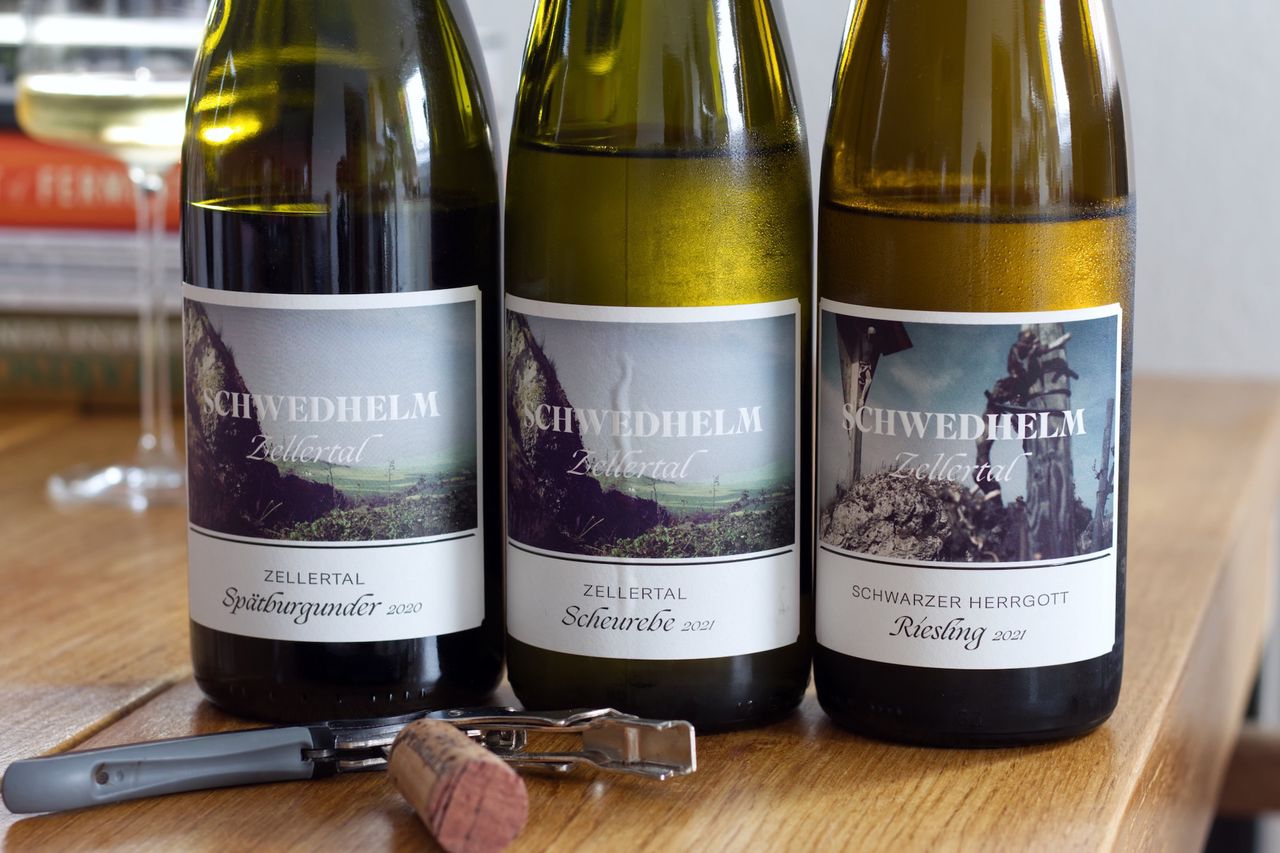Three Bottles Schwedhelm
We drink a bottle of Zellertal Scheurebe 2021, a bottle of Riesling Schwarzer Herrgott 2021 and a bottle of Zellertal Spätburgunder 2020 from the Schwedhelm Winery in the Palatinate.

It’s been ages since we were here at the southernmost tip of Rheinhessen with the wines of Christopher Full. And what is the southernmost tip for Rheinhessen is at the same time the far north for the Palatinate. Zellerweg am schwarzen Herrgott, Rheinhessen, and Zeller Schwarzer Herrgott, Pfalz, are less than a stone’s throw apart. One step too far and you change growing regions. The Schwedhelm winery in Zellertal is located in Zell, on the left side of the border in the Palatinate. On one of our tours, we’ve passed by here as well. Unfortunately, we were not smart enough to call before and of course we had bad luck and no one was there. Will not happen to us again. Anyway, just the landscape in the Zellertal is more than worth the visit, if only there were not the narrow roads, partly without lane markings, on which you are overtaken by pickups at top speed. Not the fondest driving memory in my mind. Stephan Schwedhelm took over the family winery still under the old name Klosterhof in 2006, and then with the entry of his brother Georg, the Schwedhelm winery in Zellertal was born in 2014. Today we drink three wines of the two: A bottle of Zellertal Scheurebe from 2021, a bottle of Zellertal Pinot Noir from 2020 and from the top vineyard Schwarzer Herrgott a bottle of Riesling 2021.
The Scheurebe smells like a pack of sour peach and apple rings right after opening. As far as I can remember, I’ve never had that so clearly in the glass. There is also a good amount of citrus. In the mouth, there is a lot of texture and much more structure than the intensely fruity nose would have suggested at first. You can chew on it and the juiciness does the rest. Lately, I actually like to drink Scheurebe and this one fits in seamlessly. The art is always that such a wine does not degenerate into a trivial fruit candy and this bottle is fortunately miles away from that.
The sour fruit gums disappeared overnight. There is now plenty of exotic fruit, a few green notes and just the serious structure on the palate. This is really more than just an alternative to Sauvignon Blanc, and even though it’s being encountered more and more often, it’s certainly still significantly underrated.
The Riesling from the Schwarzer Herrgott starts very yeasty on the nose. There is yellow fruit, something creamy and stone. This seems somehow still agitated and unfinished and yes, I can already hear you yelling that this is much too young at all and why I open this now already and that will never and never do justice to the wine and I was fully to blame for the taste now. True, perhaps, but I had a taste for the bottle. Therefore, we allow the Riesling instead of the usual two evenings just a third day and see what happens. Where the nose still lags, however, the usual 2021 acidity along with such a fat load of texture pull so firmly on the tongue and cheeks that the question of whether you were perhaps too early is then not so clear anymore.
Overnight, the wine becomes more barren, more mineral. The very distinct yeast note recedes and with it a bit of the extreme texture of the first evening. It has become more harmonious on the tongue. Sure, the acidity is still there, but the fine yellow fruit now makes it past the structure and has almost a bit of pineapple and a touch of sweetness at the back.
On the third evening, you can smell the fruit more clearly. The yeasty smell is now completely gone and the wine seems darker. There’s grapefruit and a lot of citrus overall. The acidity again fully dominates the mouthfeel and the texture and juiciness fight for the upper hand. I lack the experience to say where this is headed, but if the three days in the open bottle are any indication of things to come, then given the time, this is great now, but will certainly be much grander in a few years.
The Spätburgunder village wine is a real charmer, especially after the Riesling. This starts off very velvety just smelling it with fine red fruit, some wood, some smoke, cherry and violet liqueur. And also in the mouth this is gentle, soft, harmonious with light spice, some acidity that brings juiciness and the great fruit. This pats you on the back after being put through the wringer by the Riesling.
And with a day of air, amazingly, this becomes even more harmonious. It’s so nice now to sit there, hang your nose in the glass, smile quietly to yourself and then hold your nose right back in. It’s just beautiful. Not particularly challenging, not demanding. There’s also no edge or particularly much complexity, nothing that shouts out loud or wants to somehow offend or particularly profoundly demands attention. But it’s so round, so harmonious, so simply delicious, that I couldn’t care less about any criticism of it. I never understood why tasty or simply delicious could be something reprehensible in wine anyway. I think I’ll buy some more of this.